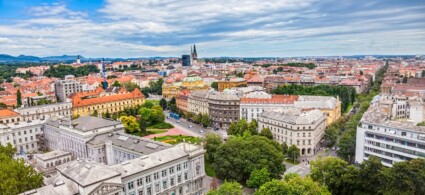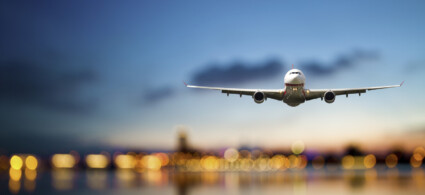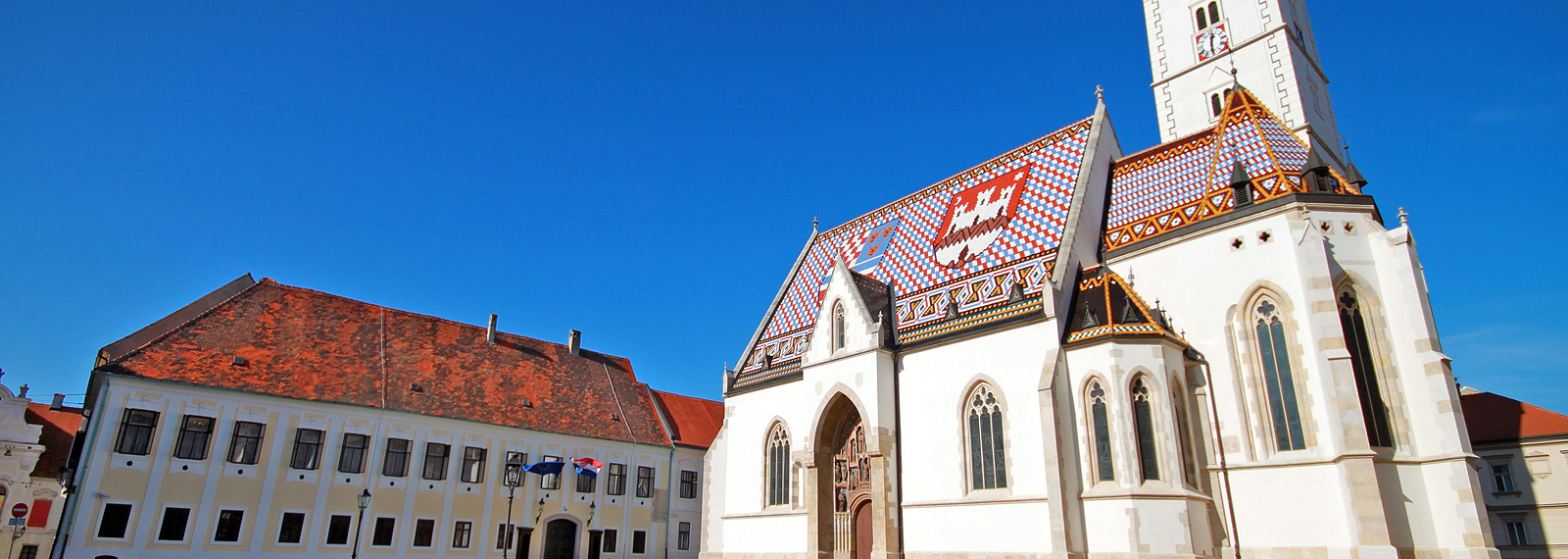

Everyone thinks of Croatia as a summer holiday destination, but its capital Zagreb is an exciting city to visit in both summer and winter.
Endowed with the old European charm we normally associate with cities such as Budapest and Vienna, Zagreb is both young and modern, with an incredible variety of museums and contemporary art galleries, cultural events, clubs and live music venues.
The unsuspected Zagreb has won European Best Destinations’ Best Christmas Market award two years in a row: no more Germany and Austria this year, buy your Christmas presents in one of Europe’s most beautiful and lesser-known capitals. Then maybe come back here in the summer to relax in its fantastic parks!
Still ignored by mass tourism, Zagreb is a city to explore, with a relaxed yet lively atmosphere that will thrill you at every turn.
Zagreb is divided into two distinct areas, linked by a funicular railway.
The Upper Town stands on a hill and is the oldest part of the Croatian capital, with historic buildings and important churches.
The Lower Town is a more recent area, where the city’s main museums are concentrated and where you can admire interesting examples of 19th and 20th century architecture.
If you are only coming to Zagreb for a weekend, a good idea is to spend the first day in the Upper Town and the second in the Lower Town.

The beating heart of Zagreb is, like many other big cities, its main square with an almost unpronounceable name, Trg bana Jelačića. Crowded all year round, the square is at its best during Advent, when the Christmas market is set up.
Very characteristic is Tkalčićeva Street, a lively pedestrian street in the Lower Town. Also in this part of the city is Illica Street, the largest, with a wide selection of shops, bars, pubs and restaurants, and another beautiful square, Preradovića Square, famous for its colourful and entertaining performances by street artists and a charming flower market.
Zagreb’s most famous market, however, is Dolac, a colourful and lively fruit and vegetable market held daily in the Kaptol district.
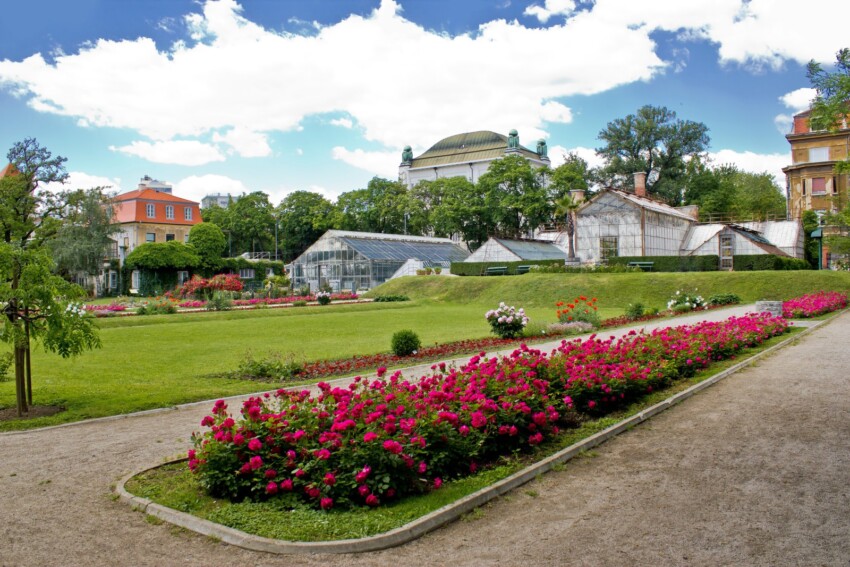
The city of Zagreb boasts numerous green areas, parks and gardens that are oases of relaxation amidst the hustle and bustle of city life.
Zagreb’s largest and most beautiful park is Maksimir Park, one of the oldest in Europe. It is an enchanting composition of English gardens, artificial lakes (no fewer than five!), gazebos, pavilions, sculptures and promenades, to which the Zagreb Zoo and a mock Swiss chalet with a café were added in more recent years.
Another fascinating place for those who love greenery are the Botanical Gardens, which run parallel to the train tracks but seem light years away from the city. With more than 10,000 species of indigenous and exotic plants, the gardens are a riot of colours and scents.
For a plunge into the past, take a stroll through the romantic Zrinjevac Park: its princely music pavilion has been an atmospheric setting for music concerts since the 19th century.
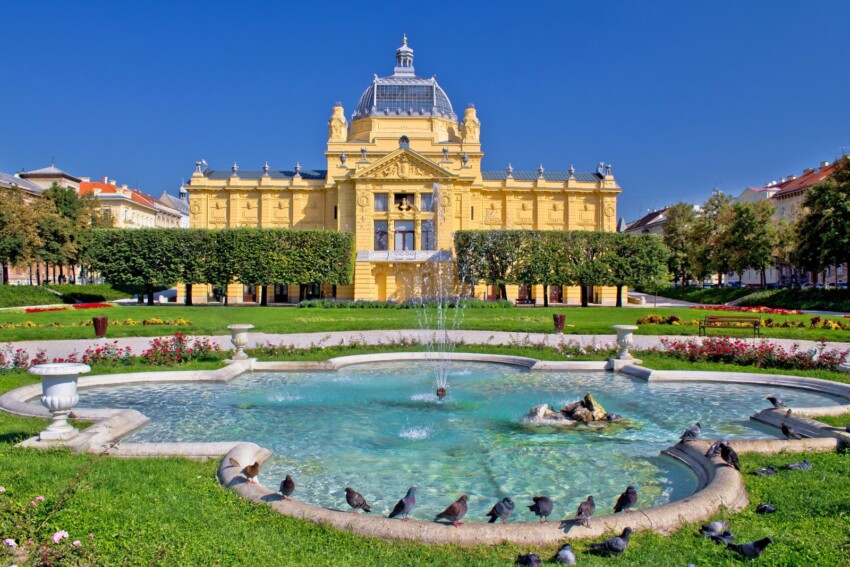
The neo-Baroque Croatian National Theatre is a symbol of the city and a source of pride for its citizens; designed in 1894, it is still a temple for fans of opera, ballet and classical music.
Another symbolic monument in Zagreb is the Sabor, or Parliament. It is a building very dear to the Croatian people because it was from the balcony of this elegant early 20th century building that Croatia’s secession from the Habsburg monarchy was proclaimed in 1918.
For a beautiful view of the city, climb up to the medieval Medvegrad Fortress, built in the 14th century to defend the city from Tatar invasions.
The fortress is located in a panoramic position on the Medvenica hill, surrounded by striking natural scenery. The slopes of the hill are criss-crossed by numerous paths that will delight hikers.
If you don’t feel like going that far, you can also enjoy a beautiful view from the top of the Lotrscak Tower in the Upper Town, also built for defensive purposes.
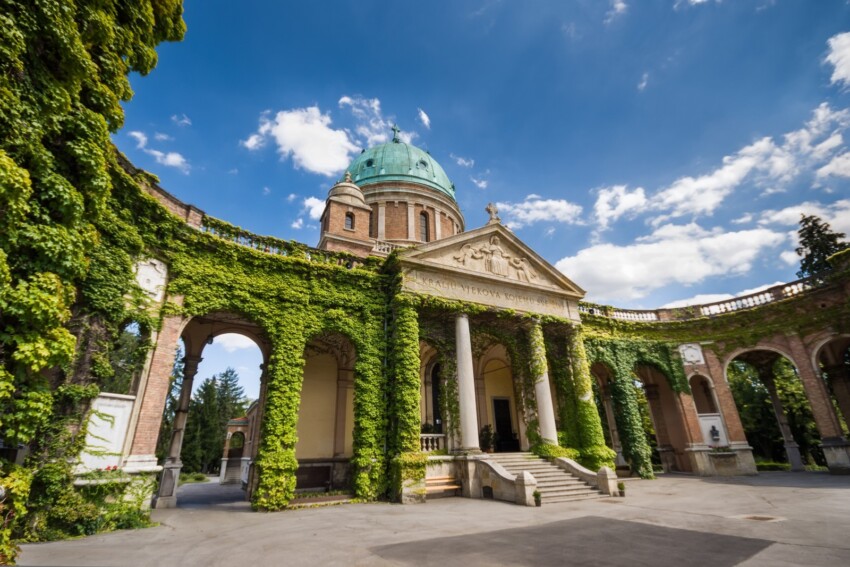
Another place that is romantic and fascinating in its own way is the Mirogoj Cemetery, one of the most beautiful in Europe, designed in the second half of the 19th century by one of Croatia’s most famous architects, Herman Bollé.
Writers, politicians and other prominent personalities from Croatian history are buried in this historic cemetery, but it is also pleasant to come here just to stroll undisturbed along the pretty avenues surrounded by greenery.

Zagreb’s most important church is the Cathedral of the Assumption of the Blessed Virgin Mary, with its twin spires soaring high into the sky. Inside this Gothic church you can admire a triptych by Albrech Dürer.
Other interesting churches are the Church of St. Catherine and the Church of St. Mark. What usually sticks in the memory of the latter is its roof, which with its coloured tiles represents the emblem of the city on one side and the medieval coat of arms of Croatia, Dalmatia and Slavonia on the other.
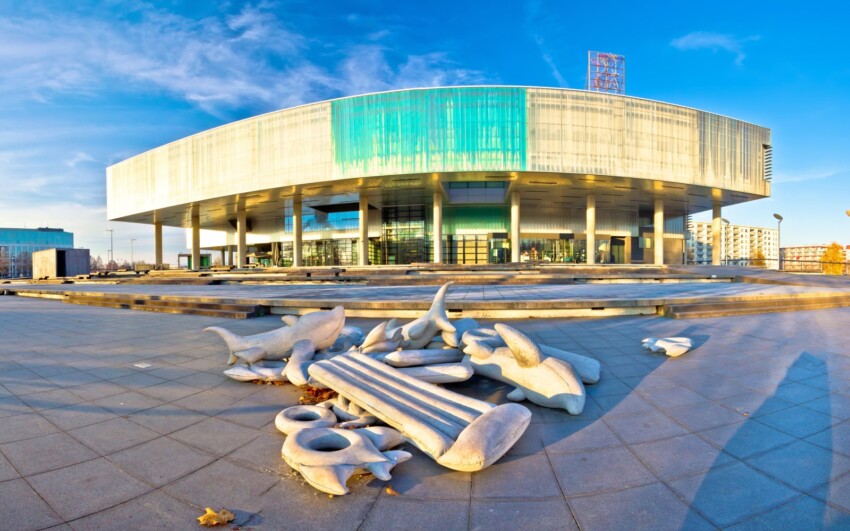
To make a list of all the museums in Zagreb would require a page of its own: there are so many and so diverse, with museums of art from every historical epoch, of technology and science, history, ethnography, handicrafts, motoring… Name an interest of yours and there will almost certainly be a thematic museum to visit in Zagreb!
The museum that attracts the most tourists is curiously enough the original Museum of Broken Hearts: born out of a travelling exhibition that met with extraordinary success, it is now housed in the splendid Baroque Kulmer Palace.
The exhibits in the museum have all been voluntarily donated by people who have ended, for good or ill, an important love affair and wanted to symbolically summarise it with an object and a short written description. There is little or nothing artistic to see, the visit to the museum is a sometimes touching, sometimes funny and certainly unique experience!
If the end of a love affair doesn’t seem like a museum-worthy topic to you, you can always visit the city’s important art museums: perhaps less emotional, but culturally more meaningful.
Here are the must-see museums for art lovers:
Zagreb is an ideal base from which to explore the wonderful sights in the surrounding area. A trip to the Plitvice Lakes or Bled Lake in Slovenia is a must.
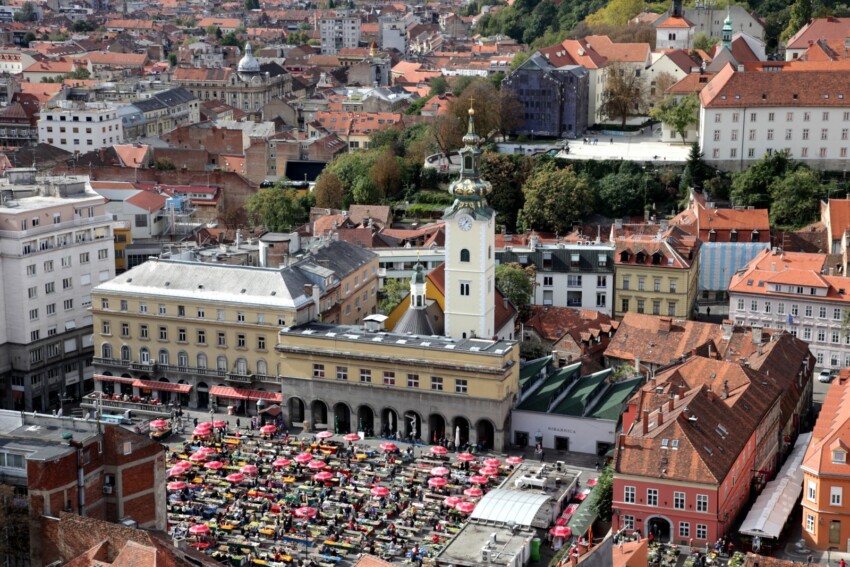
Throughout the year, Zagreb hosts a wide range of events, festivals and exhibitions, including theatre and film festivals, classical and rock concerts, traditional festivals and trade fairs.
The International Folklore Festival, which has been taking place in July for more than 50 years, is probably the most fascinating and enthralling event for tourists. During five days, the city comes alive with traditional Croatian dances and songs performed by artists in typical costumes. The programme is really rich and also includes performances by international guests, workshops, world music concerts and exhibitions.
Other highlights include the Summer Festival, Animafest – Animated Film Festival and InMusic Festival, three days of rock and indie music in the beautiful setting of Jarun Park.
Also not to be missed is the street artists’ festival Cest is D’Best. In August, the streets of Zagreb are invaded by hundreds of artists from all over the world and their performances ranging from music to theatre, from children’s activities to sport.
The capital of Croatia, Zagreb is a vibrant and diverse city that has something to offer everyone: whether you’re looking for a romantic getaway or an exciting adventure, Zagreb has the perfect accommodation for your needs. With its wide range of hotels, hostels, flats and guesthouses, Zagreb is one of the best European cities to stay in.
The centre of Zagreb is the best part of the city to stay in. Here you can find a wide range of accommodation options, from budget hostels to luxurious five-star hotels. The city centre is also home to some of Zagreb’s main attractions, including the Museum of Arts and Crafts, the Museum of Contemporary Art and Zagreb Cathedral. The city centre is also the best place to find a variety of restaurants and bars. The main square, Ban Jelacic Square, is a great place to grab a bite to eat or a drink.
Reaching Zagreb, given its proximity to other European capitals, is very easy by plane, thanks to the presence of the international airport.
International trains from Eastern Europe arrive at Glavni Kolodvor, Zagreb’s main railway station. Glavni Kolodvor station is also connected with the other capitals of the former Yugoslavia and other cities on the Croatian coast.
From the station, to get to Trg Bana Josipa Jelacica square, take tram no. 6 or no. 13.
In addition, the bus station, Autobusni kolodvor, is located on Avenija M. Držica bb and is served by all international bus companies arriving in Zagreb, as well as by the bus from Zagreb Airport.
Zagreb boasts an extensive bus and tram network for getting from one part of the city to another quickly. To get from the Lower Town to the Upper Town you can take the distinctive Zagreb Funicular.
In the centre of Zagreb, it is very easy to get around by tram, with 15 lines available. To get to the outlying districts, however, it is advisable to travel by bus. From Zagreb’s Glavni Kolodvor station to Trg Bana Josipa Jelacica square take tram No. 6 or No. 13.
To travel between Strossmayerovo šetalište, in the Upper Town, and Illica Street, in the Lower Town, there is the Zagreb Funicular, 66 metres long with a gradient of 52%.
In addition, to get from one Zagreb district to another quickly, you can take a taxi by stopping on the street or booking it by phone.
In order to travel to Zagreb and Croatia in general, EU citizens must be in possession of a valid identity card or passport with a residual validity of 90 days from the planned end of stay.
European citizens do not require a visa for tourism or short business visits not exceeding 90 days. Within 48 hours of entering Croatia, tourists must register their presence with the local police authorities. This procedure is usually carried out by hotel establishments.
Local regulations allow foreigners and tourists visiting or in transit through Croatia the import and export of domestic and foreign currency in cash and cheques without limitation, with the obligation to declare to the customs officer operating at the border crossing any cash import or export exceeding 10,000 euros.
Border authorities may deny entry to the country to anyone who does not prove that they have sufficient means to guarantee their subsistence in Croatia, quantified at EUR 100 per person per day.
What's the weather at Zagreb? Below are the temperatures and the weather forecast at Zagreb for the next few days.
Zagreb is the capital of Croatia and the country's largest city. Located in the north-west of the country, on the Sava River, Zagreb is the political, economic, cultural and educational centre of Croatia.
